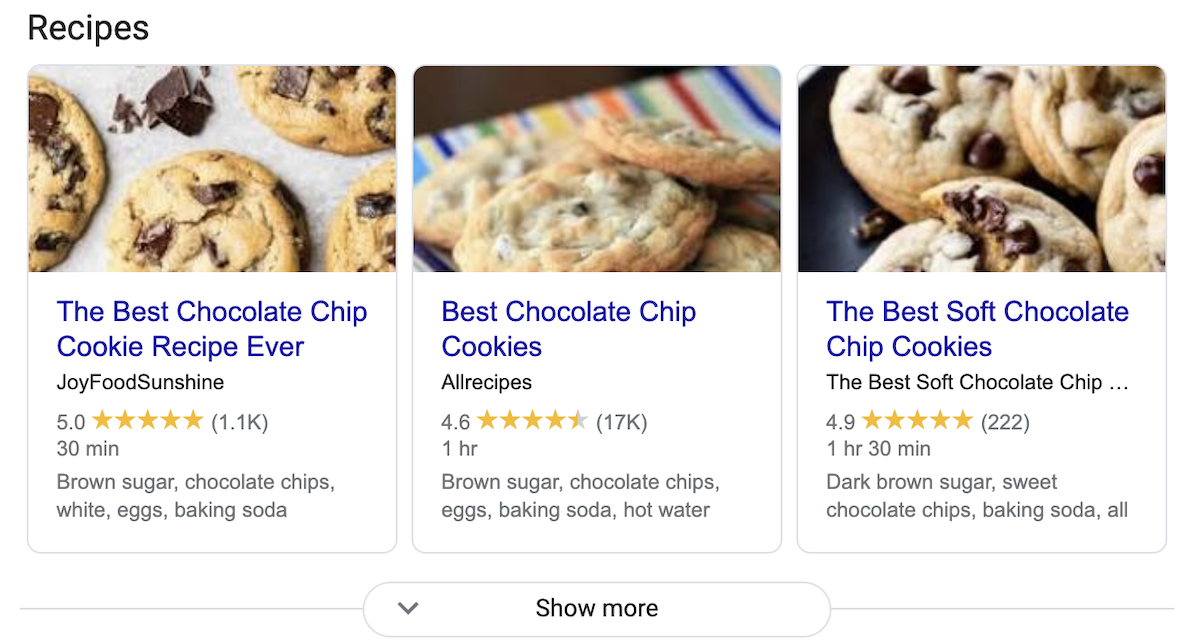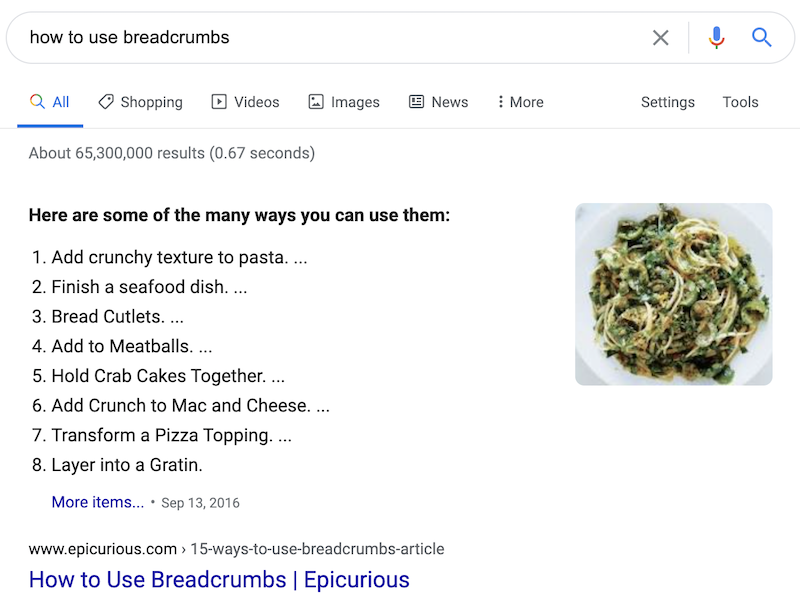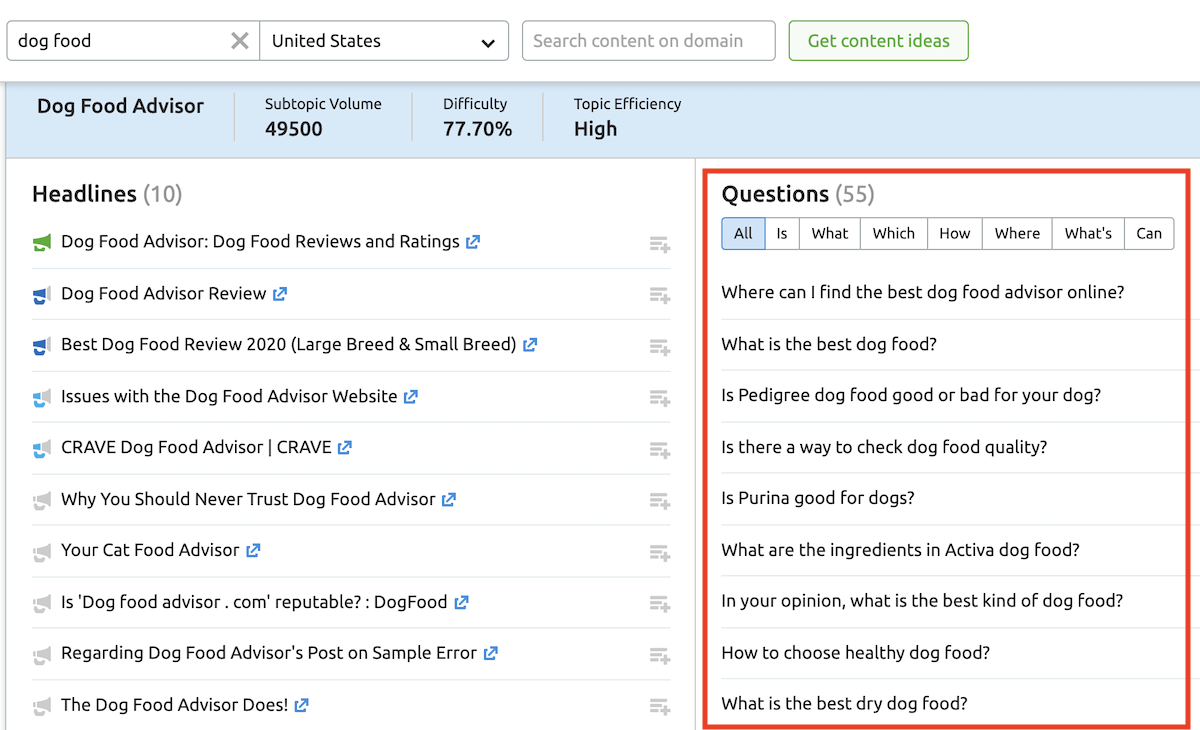Structured data is information that is added to a page’s HTML markup and helps search engines to not only crawl your website but also to understand it better. Search engines use this information to generate rich snippets, which were introduced as early as in 2009, and refer to the extra bits of text that appear under the search results
Structured data helps search engines to better understand the content on your website and to provide their users with the best search results. There are two forms of structured data categories that Google uses:
Rich results: Google can use the structured data markup you provide for your pages to feature your content in a visually compelling way, such as reviews, recipes, videos, etc.
Knowledge Graph cards: If your website is authoritative for particular content, Google can import your structured data into the Knowledge Graph cards that appear for well-known entities, such as people, places, and organizations.
With these different displays of information, structured data has a significant influence on SERPs, Google’s in particular.
During one of our SEMrushchats, we discussed search, structured data, and Knowledge Graph with Aaron Bradley, the Senior Manager of Web Channel Strategy at Electronic Arts, and our other chat participants.
Let’s dive deeper into the topic!
SERP Features Triggered by Structured Data
Over the last decade, Google’s search result pages have evolved significantly. The search engine now displays search results in different ways based on structured data and context. These are the best SERP elements that are triggered by structured data (according to our chat guests):
Featured Snippets
When a searcher asks a question in Google Search, Google puts the search result in a special block that appears at the top of the SERP, which is called a featured snippet (sometimes referred to as “position zero”). It extracts a summary of the answer from a webpage, along with a link to the page, its title, and URL.
Position 0 Example:

Getting your content into the featured snippet can help you to increase visibility and outrank your powerful competitors. Also, taking into consideration the proliferation of voice search, the position zero is going to be the next great battlefield in the SEO world. According to STAT, voice search will continue to gain in popularity over the coming years, which means that there will be a lot more featured snippets to support it.
Matthew Young — "Featured snippet for sure. It's a windfall of visibility. Easier said than done though." Ryan Glass — "My favorite is when we have snagged a featured snippet for competitive comparison terms (brand vs brand, best product, etc)."Rich Cards
We know that Google is constantly improving the quality of its search results. Therefore, by introducing Rich Cards in May of 2016 they took it a step further. Before then, it was only used for things like movies and recipes, however, Google is now expanding its rich cards.
Google updates options often. Check out their gallery for options.
Aaron Bradley — "Hearing lots of "featured snippets", which is great/true ... but think rich *cards* y'all, just to keep focus on mobile."Recipes
Google can also present recipe results in a visually appealing format, thanks to the rich snippets that work in the background to ensure success.
Using schema on your website increases the chances that Google will show rich snippets for your site because the search engine can understand what exactly it is you’re talking about. For example, if you are looking for a chocolate chip cookie recipe, schema markup will help Google to find recent, and well-rated, recipes:

Matt Lacuesta said, "I have had a lot of success with Recipes for CPG brands; great improvement in clicks and upped engagement metrics significantly." Danny Ray Lima said, "Recipe mark up is one of my favorites, and it transfers over to social like Pinterest."
Bulleted and Numbered Lists
Google places importance on well-organized pages. Assuming that people usually skim search results and webpages to quickly find what they need, breaking up page elements with headings and lists is highly important.
Rich snippets can be displayed in the form of bulleted and numbered lists, plus, relevant, optimized, and well-structured content has a higher chance to appear in a Google Quick Answers box, which is highly-visible text snippet answers.
Here is an example of a numbered list.

Bradley made a very good point, saying that “the best rich result is always that that gives the data type marked up the maximum visibility in search.”
Using Schema to Markup Landing Pages For Product Reviews and Prices
Schema markup tells search engines what your content really means. To implement structured data, you need to provide search engines with the correct markup. By adding markup to your product pages you help Google to provide detailed product information in rich search results.
It means that searchers will be able to see availability, price, and reviews right on the search results.
There are two kinds of product information that can be displayed in search results:
1. A product page that describes a single product and can include markup for:
Review AggregateRating Offers2. A shopping aggregate page that describes a list with a single product and information about different sellers that provide that product.
You need to make sure that your landing page contains a Schema.org Product type — which is a product or service you are offering. It should also contain an Offer type — which is a description how your product or service is sold.
However, if a single product is associated with multiple offers, you can use AggregateOffer, i.e: the same gadget is offered by several different merchants.
"For customizable products, markup Product as usual, but employ AggregateOffer w/ lowPrice & highPrice properties."
— Aaron Bradley
By combining some properties from schema.org/offers, you are able to add a price to the snippet. You can then employ AggregateOffer with highPrice property (i.e., the highest price of all offers available) and lowPrice property (i.e., the lowest price of all offers available).
Once you have obtained some reviews, you can then add them to your product pages. You can find all specifications for product reviews on Schema.org/Product.
Let’s sum up these key points.
Technical SEO Tasks for Featured Snippets
Featured snippets present a challenge to website owners and digital marketers by sometimes eliminating the need to ever click through to their sites. Nevertheless, features snippets also provide them with an opportunity to significantly boost their site visibility.
Our chat guests shared their tips for getting featured snippets for your site:
Pay Attention to Basics
Aaron Bradley recommends using basic HTML tags, including <p>, <ul>, <li>, <table>, <h>. Featured snippets can come in different forms, which includes lists and tables. The <table> tag defines an HTML table, and the <ul> element defines an unordered list. To create a bulleted list, you need to use this tag together with <li>. If you want to add an ordered list to your content, you should use the <ol> element.
The STAT team found the two types of on-page markup that frequently appeared in featured snippets: <ol> and <table>. According to their findings, a <table> markup appeared 21.8% more frequently in featured snippet results than on regular search results. As for an <ol> markup, it appeared 41.6% more often
“Use markup where necessary, and use formatting that appeals to featured snippet presentation, like tables,” tweeted Matthew Young.
Find Out What Questions Searchers Are Asking
The key to getting into the desired position is to figure out which questions Google users are asking in your industry and how your content should answer those queries. This means that you need to identify a common question related to your niche and then provide a clear and direct answer to that question.
However, keep in mind that you need to provide a real value beyond your answer as well.
"Create content around questions that are commonly searched and use markup where it's needed in the content."
— Netvantage Marketing
Aaron Bradley also suggested paying attention to the five W’s and H: who, what, where, when, why, and how.
Traditionally, professional journalists were trained to answer the five questions when they write an article or press release, but some authors added a sixth question, “how.” You can use these basic questions for brainstorming and keyword research to come up with the right content for your audience.
Our SEMrush Topic Research tool can help you find the questions people are asking in real-time.

Use Natural Language
The 2019 SEMrush Voice Search study found that 70% of all answers returned from voice searches occupied a SERP feature (with 60% of those returning a Featured Snippet result). This tells us that the ability of search engines to understand natural language and the intent behind queries is grown substantially.
With access to more detailed information about users, such as what devices they are using, search engines will better interpret the meaning behind a search query.
"Use natural language in content. Consider how someone would ask the question you are answering."
— Donna Snow
To increase your chances of getting featured snippets, it is worth incorporating natural language into your content and speaking in a more conversational tone. By doing so, you can make your content more visible, as the way users are searching for things is changing.
"Provide natural language questions & answers on your pages based upon queries people Google to generate featured snippets."
— Bill Slawski
As Andy Drinkwater @iqseo pointed out, you need to markup your HTML correctly and structure your pages well. Then, you need to create content around questions that your users are likely to be asking.
You can also learn How to Earn Google Featured Snippets for Mobile.
Which is Best, Knowledge Graph or Featured Snippet?
During our discussion, we talked about both featured snippets and knowledge graphs. However, it was interesting to know which of them our chat participants would prefer if they had to choose just one for their main keywords.
Both knowledge graphs and featured snippets appear at the top of the SERPs, however, a featured snippet is a short summary which aims to provide the best answer to a question asked in Google search. It includes the link to the full webpage where the snippet of content was found.
Aaron Bradley — "False choice, as you should always target BOTH. :) Featured snippets for "question" keywords, Knowledge Graph for entity-facing keywords, where you want to see corporate contacts, logos, social profiles, hours in your Knowledge Graph panel."On the other hand, a knowledge graph is designed to provide some basic information about a particular person, place, company, product, or thing. It serves as a quick reference point for further information and doesn’t provide navigational links to a specific webpage.
A knowledge graph's result is general information that is collected from all across the web. When Google successfully identifies an entity, the search engine can generate a knowledge graph card for it, which includes a compilation of information from different sources.
Bill Slawski — "A knowledge Graph serves as a representation of the entity behind your site & provides validation about that entity."If your best keywords are the ones that focus on answering specific questions that your users may ask, it’s worth aiming your efforts to get your content displayed in a featured snippet. On the other hand, as Aaron Bradley pointed out, a knowledge graph is for entity-facing keywords, where you want to see your business information, like corporate contacts, logos, social profiles, and hours in your knowledge panel.
Aaron also remarked that you always need to target both featured snippets and knowledge graphs. However, some of our chat participants voted for the latter:
Matt Lacuesta — "It's like picking a favorite child! It's a tough 1, but I'd take Knowledge Graph. Drive more traffic if you're answering Qs." Andy Drinkwater — "I think you would need to do research and see which one was better going to serve you."Local SERP Features That Increase Organic Traffic
Lastly, we asked our chat guests to name local SERP features that helped them or their client’s site increase organic traffic. Here’s what they answered:
Consistency in Data
As many of you already know, the SEO landscape is becoming more and more competitive. Therefore, some businesses must begin to focus on smaller, local markets.
When it comes to local search, consistency is vital for your site to build local SEO authority. You need to provide accurate information about your business, such as your business name, address, phone number, hours of operation (if applicable), and other important details.
Aaron Bradley —
"Consistency in the data you provide is important. for local. Your markup and your GMB listing should provide the same info."
A Strong Presence on Google My Business
Google My Business provides businesses with a real opportunity to connect with their customers. Information in the Knowledge Panel and Maps comes straight from your Google My Business page. Therefore, it is very important to provide accurate, updated information on your GMB page.
“A knowledge panel can list Web and critical reviews, ratings, social profiles, appointment booking, and menu links. Verify in GMB,” tweeted Bill Slawski. From the GMB interface, you can keep your details up to date by changing your contact information, address, hours of operation, and other details when needed.
Further Reading: Google My Business Tips from Greg Gifford
Rich Snippets Stars
A user is more likely to click on a product with a "star" rating. Imagine this: you rank well for your product, but your competitor has rich snippets and you don’t. They show their reviews directly in the search results and these start to naturally catch users' eye. If their rating is high, your rival can attract even more clicks from searches, because their profile looks more natural and trustworthy. “
You'll never beat a good review portfolio. Bringing up my scores for hotels and restaurants have always killed it!”, tweeted Tim Welsh.
Using rich snippets for reviews enables a star rating to show up next to your search result. To get the review stars on your site, you need to markup your webpage with AggregateRating.
"Review Star Rich Snippets. Tools like GetFiveStars make is easy for clients to earn reviews that are marked up.", Brian Jensen.
Popular Times
In addition to other elements, Danny Ray Lima named popular times. To help customers plan their visits to your business, Google can display popular times, which appear below your regular business details on Maps and Search.
This feature helps your customers decide when to visit you. In November of 2016, Google announced the expansion of its popular times feature within Google Maps, which means that Google Maps now shows how busy or how slow a particular venue is in real-time.
However, it's important to know that site owners can not manually add this information to their location, because Google uses anonymized data from those users who have opted into Google Location History to figure out these popular times.
"The local knowledge graph is always a nice win, highlights NAP, Reviews, Hours, and in some cases Popular times."
— Danny Ray Lima
To find out ways to optimize your site for local search, you can check out this post on local SEO strategies for small businesses.
Google has dedicated guides to structured data, and it is likely to continue growing in importance, so make an effort to add it to your site now and improve your visibility in SERP results.
We would like to thank Aaron Bradley and our other chat guests who made this discussion interesting and productive!
Innovative SEO services
SEO is a patience game; no secret there. We`ll work with you to develop a Search strategy focused on producing increased traffic rankings in as early as 3-months.
A proven Allinclusive. SEO services for measuring, executing, and optimizing for Search Engine success. We say what we do and do what we say.
Our company as Semrush Agency Partner has designed a search engine optimization service that is both ethical and result-driven. We use the latest tools, strategies, and trends to help you move up in the search engines for the right keywords to get noticed by the right audience.
Today, you can schedule a Discovery call with us about your company needs.
Source:





